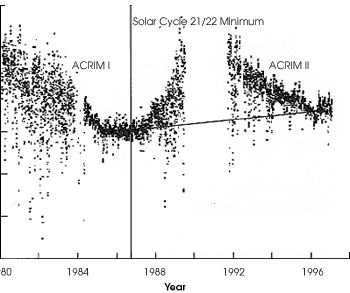| |
Variations in Total Solar Irradiance
The ACRIM I instrument was the first to clearly demonstrate that the total
radiant energy emanating from the sun was not a constant, and varied in
proportion to solar magnetic activity. However, the sun’s output changes so
slowly and solar variability is so slight (less than 0.00425% of the total
energy per year on time scales of days), that continuous monitoring by
state-of-the-art instrumentation is necessary to detect changes with climate
significance. Scientists theorize that as much as 25% of the 20th century
anticipated global warming of the Earth may be due to changes in the sun’s
energy output. Systematic changes in irradiance as little as 0.25% per century
can cause the complete range of climate variations that have occurred in the
past, ranging from ice ages to global tropical conditions. For example,
scientists believe the "Little Ice Age" that occured in Europe in the late 17th
century could have been related to the minimum in sunspot activity (and a
correlated minimum in total solar irradiance) that occured during the same
period.
|
|
 ACRIMSAT
Introduction
Variations in Total Solar
Irradiance
Total Solar Irradiance Data in Climate
Studies
Total Solar Irradiance Data in Solar
Studies
Related Data Sets
Outgoing Longwave Radiation
Related Sites
ACRIM Instruments
ACRIMSAT
left: Total solar irradiance measured by ACRIM I and ACRIM II.
The overall trend of decreasing then increasing energy is caused by the
solar sunspot cycle. (Graph courtesy of Dr. Richard C. Willson, ACRIM III Principal Investigator, Center for Climate Research, Columbia University) |




